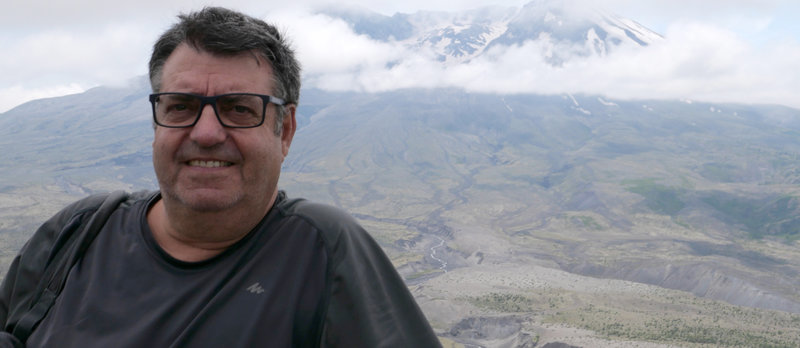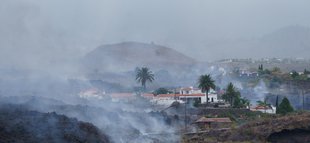Joan Martí
DIRECTOR OF THE BARCELONA INSTITUTE OF GEOSCIENCES (CSIC)
“We still know very little about natural hazards”
Expert volcanologist Joan Martí explains why Cumbre Vieja erupted and the differences with our own volcanic zone of La Garrotxa
Joan Martí (Balaguer, 1957), holds a PhD in geology, is a research professor at the CSIC and Director of the Barcelona Institute of Geosciences (CSIC). He specialises in physical volcanology and volcanic risk. He has also been Director of the International Volcanology Course at the University of Girona since 2011. He has supervised 30 doctoral theses and has authored more than 270 scientific works.
Our screens have been filled with images of the Cumbre Vieja volcano in La Palma erupting for the past few weeks. Special attention is being paid to the events here in Catalonia, as we also have the volcanic area of La Garrotxa. In the days since Cumbre Vieja has been active, the lava from the volcano has swept aside everything in its path down to the sea, with thousands of people affected. Geologist and volcanologist Joan Martí answers our questions on the subject.
How far can we describe what’s happened in the Canary Islands as normal? What caused the eruption?
We can say that it is completely normal in an active volcanic zone subjected to the tensions of the tectonic plates that surround it. The Canary Islands have had volcanic eruptions before and will continue to do so for many more years, on both a human and a geological scale.
Nature acts according to its laws.
The cause of this eruption is the accumulation of magma, molten rock, which has risen from where it originates to surface levels, just below the volcanic edifice of La Palma. This has caused extra pressure, which has fractured the rocks around it, making its way to the surface and starting the eruption.
It’s logical for us to think of our own volcanic zone. How possible is it that an eruption could occur here?
It’s just as possible, although here the tectonic movements that cause magma generation and its migration to surface areas are much more spaced out… we’re talking about tens of thousands of years.
These days we hear scientists talking about the ability to predict these phenomena. What is the time frame for alarms to be detected and triggered? Also, it’s also been pointed out that this eruption may last between two weeks and two months. How are eruptions measured?
When a volcano prepares to erupt, that is, when the magma inside receives so much pressure that it breaks the rocks that surround it and comes out, we almost always detect an increase in seismic activity on the surface, a deformation of the ground and a release of gases due to the presence of magma. These elements tell us how close the eruption is. And eruptions last as long as it takes to expel all the excess magma that is causing the excess pressure. If we compare it with similar eruptions – in terms of volume of expelled magma and eruptive dynamics – that have occurred in the same area throughout history, we know that the precedents lasted between two weeks and two months, approximately.
It is essential to anticipate eruptions and have evacuation plans in place. Is there any other solution, other than not making human settlements nearby?
Forecasting and knowing how to evacuate are clearly necessary, along with an assessment of the potential volcanic hazard based on analysing what has happened before, which is on record. This is the information that the relevant administrators and politicians should use to carry out effective spatial planning and avoid disasters.
As mentioned, volcanic areas are a source of wealth for humans. How can this be made to be compatible with safety?
Through good knowledge of what these volcanoes represent, their dynamics and the dangers they can involve.
On social media there have even been links made between this eruption and the climate crisis.
We’re not at that point yet. Volcanic activity in the Canary Islands is a consequence of the region’s geodynamics and not of external agents such as climate change.
In the case of the Canary Islands, from what we are seeing there are no explosions and it does not seem that gases will cause problems. Might this change?
I don’t think there will be any significant changes in this eruption. As we said, from what we know of similar eruptions in the same area, it will do the same, it will gradually lose intensity until it ends.
And in the future, there will be eruptions that continue to affect us.
Modernisation greatly increases the vulnerability of society and episodes such as La Palma will be increasingly more severe and have more impact on us. We are very surprised by natural events. The problem is that the general public know very little about the dangers and risks they can pose. It’s not part of our culture, that’s just the way we are!
interview
The volcanic zone of La Garrotxa: no signs of reactivation
The events of La Palma make us shudder, due to the damage caused, and because they evidence human impotence in the face of natural acts of such proportions. A tongue of burning lava up to 12 metres high and hundreds of metres wide, slowly devouring everything it encounters. It advances slowly, but nothing can be done about it.
This September, scientific discoveries were published regarding the volcanoes in Catalonia. The presentation took place at the Camp dels Ninots volcano in Caldes de Malavella, just a few days before the eruption began in La Palma. Experts - among them Joan Martí – say that it is “highly unlikely” there will be a volcanic eruption in Catalonia like that taking place in La Palma. At least not in the near future.
The National Geographical Institute tells us: “La Garrotxa is considered an active region from the point of view of volcanic activity, with eruptions every few thousand years. The area has had the most recent volcanic eruptions on the Iberian Peninsula, with volcanoes that make up one of the most important volcanic landscapes in continental Europe.”




